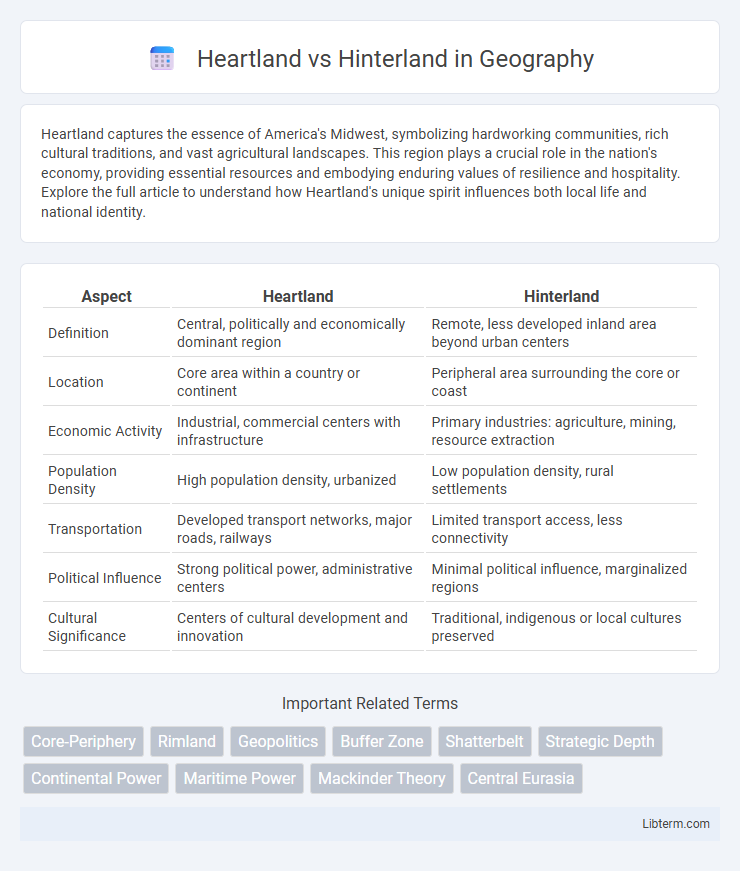Heartland captures the essence of America's Midwest, symbolizing hardworking communities, rich cultural traditions, and vast agricultural landscapes. This region plays a crucial role in the nation's economy, providing essential resources and embodying enduring values of resilience and hospitality. Explore the full article to understand how Heartland's unique spirit influences both local life and national identity.
Table of Comparison
| Aspect | Heartland | Hinterland |
|---|---|---|
| Definition | Central, politically and economically dominant region | Remote, less developed inland area beyond urban centers |
| Location | Core area within a country or continent | Peripheral area surrounding the core or coast |
| Economic Activity | Industrial, commercial centers with infrastructure | Primary industries: agriculture, mining, resource extraction |
| Population Density | High population density, urbanized | Low population density, rural settlements |
| Transportation | Developed transport networks, major roads, railways | Limited transport access, less connectivity |
| Political Influence | Strong political power, administrative centers | Minimal political influence, marginalized regions |
| Cultural Significance | Centers of cultural development and innovation | Traditional, indigenous or local cultures preserved |
Defining Heartland and Hinterland
The Heartland refers to the central, economically dominant region of a country, often characterized by advanced infrastructure, dense population, and significant cultural influence. In contrast, the Hinterland denotes the more remote, less developed areas surrounding the Heartland, typically reliant on natural resources and agriculture. Defining these regions highlights disparities in economic activity, accessibility, and urbanization within national geography.
Historical Evolution of Heartland and Hinterland Concepts
The historical evolution of Heartland and Hinterland concepts traces back to geopolitical theories by Sir Halford Mackinder, who introduced the Heartland as the pivotal area of Eurasia controlling global power. The Heartland concept emphasizes central landmasses with strategic dominance, while the Hinterland refers to the peripheral regions supporting economic and resource extraction activities. Over time, these concepts shaped geopolitical strategies and economic development patterns, highlighting the interplay between core influential zones and their surrounding, resource-rich hinterlands.
Geographic Characteristics of Heartland Regions
Heartland regions are typically characterized by fertile soil, moderate climates, and abundant freshwater resources, which support extensive agricultural activities and dense population centers. These areas often feature flat to gently rolling terrain, facilitating transportation and infrastructure development critical for economic growth. In contrast to hinterlands, heartlands serve as cultural, political, and economic hubs, anchored by stable geographic conditions that promote sustained human settlement and resource exploitation.
Economic Roles of Hinterland Areas
Hinterland areas play a crucial economic role by serving as resource-rich zones that supply raw materials, agricultural products, and labor to Heartland regions with dense population centers or industrial hubs. These areas support economic growth in the Heartland by facilitating trade, exporting goods, and providing essential inputs for manufacturing and consumption. The interdependence between Heartland and Hinterland regions drives regional development and shapes the distribution of economic activities.
Political Influence: Heartland vs Hinterland
The Heartland, characterized by its economic hubs and urban centers, wields significant political influence due to concentrated populations and robust infrastructure supporting policy-making and governance. In contrast, the Hinterland, marked by rural and remote areas, often encounters limited political representation and reduced access to governmental resources, leading to disparities in policy impacts and regional development. This political divide shapes national priorities, with Heartland interests typically dominating legislative agendas over Hinterland concerns.
Urbanization and Population Distribution
Heartland regions, often characterized by urban centers with high population densities, serve as economic and cultural hubs driving extensive urbanization and infrastructural development. In contrast, Hinterland areas exhibit lower population densities, predominantly rural landscapes, and slower urban growth due to limited economic opportunities and geographic isolation. Population distribution heavily favors Heartlands, reflecting a concentration of resources, employment, and services that attract migration and accelerate urban expansion.
Infrastructure and Connectivity Differences
Heartland regions typically benefit from advanced infrastructure, including extensive road networks, railways, and digital connectivity, facilitating efficient transportation and communication. Hinterland areas often face challenges with limited infrastructure development, resulting in reduced accessibility and slower economic growth. Investments in bridges, highways, and broadband in hinterlands are crucial to bridge the connectivity gap with more developed heartland zones.
Resource Allocation and Development Gaps
Heartland regions typically receive greater resource allocation due to their economic centrality, resulting in advanced infrastructure, higher investment, and faster development. Hinterlands suffer from limited access to capital, infrastructure, and government services, exacerbating development gaps between urban centers and peripheral areas. Addressing these disparities requires targeted policies to redistribute resources and promote inclusive regional growth.
Cultural Identity in Heartland and Hinterland
The Heartland embodies a cultural identity deeply rooted in traditional values, community cohesion, and agricultural heritage, reflecting stability and longstanding social norms. In contrast, the Hinterland's cultural identity is shaped by its frontier spirit, diversity from migration, and adaptive practices driven by geographic isolation and economic challenges. These distinctions influence regional attitudes, social customs, and collective memory, emphasizing the Heartland's preservation of legacy and the Hinterland's dynamic cultural evolution.
Future Trends: Balancing Heartland and Hinterland Growth
Future trends indicate a strategic shift toward balancing Heartland and Hinterland growth, emphasizing infrastructure development and digital connectivity to enhance economic integration. Investment in technology hubs and sustainable agriculture in hinterland regions fosters diverse economic opportunities, reducing regional disparities. Policymakers prioritize transportation networks and renewable energy projects to support balanced regional development and long-term resilience.
Heartland Infographic

 libterm.com
libterm.com